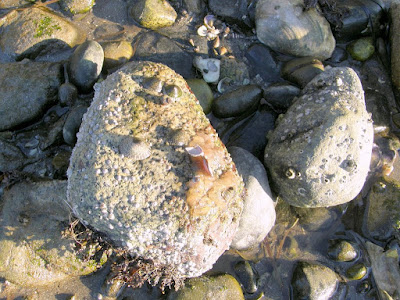I was flipping rocks on Crescent Beach, always remembering to put them back where I found them before the animals there got sunburned. (Crabs that had moved to the new bottom, now had to reverse direction.) On the underside of many rocks, this last week, I found masses of a yellowish, flecked jelly:

Flipped rock, with limpets and jelly.

Closer view of the jelly, with snails. (Sitka periwinkle, Littorina sitkana.) It reminds me of tapioca pudding.
They looked like egg masses to me. But whose eggs?
I had to search long before I found them. Each type of mollusk lays their eggs in a particular formation; the individual stalked "sea grapes" of the whelks, tiny "donuts" of the chink snails, strips, spirals (sea slugs), the eel-grass coating I found on this beach last year (still unidentified), and these blobs. Unfortunately, few books and websites mention these eggs; even fewer show recognizable photos, and fewer still link the photos to the specific creature that lays them. Most of the egg masses that I found had snails on or around them, but they were a mix; mud snails, periwinkles, whelks and black turbans.
I read up on all the snails, and finally found a PDF from the Alaska Natural Heritage Program, on the Sitka periwinkle. Not only does it describe the snails, but it includes a paragraph on reproduction with a description of the eggs. (No photograph, though.) And the descriptions match!
"After copulation females lay 50-400 fertilized eggs which are enclosed in a thick, transparent, gelatinous material; individual egg masses measure 5-15 mm but communal laying by several females often results in large egg masses measuring up to 10 cm, containing 2,000 or more eggs. ... Egg masses usually attached to and under rocks and seaweed in the upper intertidal zone."Most of the egg masses I found were these communal sites.
That's a lot of eggs! I did a bit of calculating; at a minimum of 50 eggs per female, a success rate of only 4% will maintain the population. (They need 2 successes per male/female pair.) With 400 eggs, half a percentage point will do. In other words, most of these eggs won't make it.
From the PDF, again:
"Veliger (snail larva) develops shell within a week inside egg case, then hatches in around 30 days and begins to consume jelly of egg mass and diatoms which may have colonized the jelly surface."Survival of the quickest, I think you could call that.

The individual eggs in the jelly catch the light. They vary, in different masses, from pale yellow to a burnt orange.
Someone had been flipping rocks on the beach before I got there. Where they had exposed egg masses and left them face up, the jelly was dry, and looked cracked and lifeless. It was a good reminder of the importance of leaving things as I found them.
.


I admire your perseverance with this!
ReplyDelete